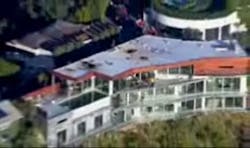Gypsum Board Ceiling Systems and Firefigher Safety
The recent events in Los Angeles and the line of duty death of veteran LAFD Firefighter Glenn Allen who died Friday from injuries he sustained when a ceiling collapsed on him in a house fire late Wednesday night in the Hollywood Hills again gives us pause to reflect on the demands and hazards present at all fire suppression operations in buildings on fire.
The past two months have borne consist reports of floor, roof, wall and ceiling collapses leading to firefighter injuries and line of duty deaths.
The importance of maintaining heightened situational awareness, identifying and monitoring suspected or inherent building construction hazards coupled with inherent occupancy risk factors, and aligning those with strategic objectives, incident actions plans and tactical deployment operations. Building Knowledge equating to firefighter safety is still a driving principle that is formulative to all firefighting operations in buildings, occupancies and structures.
Let’s take this opportunity to gain some insights into the material that compromises nearly all wall and ceiling membrane systems and assemblies in nearly all buildings, occupancies and structures; that is gypsum board components. I’ve included a number of video clips that center on our discussion, as the videos center on the operation parameters at this extremely large (floor area/square footage) residential occupancy. Most clips have good coverage of the structure and firefighting efforts. Take a few moments to review these clips before you proceed; Go Here for the Video
Gypsum board is the generic name for a family of panel-type products consisting of a noncombustible core, primarily of gypsum, with a paper surfacing on the face, back, and long edges.
In 1888, Augustine Sackett used plaster of Paris sandwiched between several layers of paper to produce what would eventually become “Sackett Board,” the original gypsum board. By the 1950s, many innovations in gypsum board technology had been developed, including the listing of many fire-resistance rated designs, rounded edges, specialized nails, curved partitions, studless partitions, sound control systems, lightweight gypsum lath, plaster, and gypsum board systems that fueled a boom period for the use of gypsum products in both the residential and commercial construction industries.
By 1955, an estimated 50 percent of new homes were built using gypsum wallboard. Lightweight gypsum board systems permitted the use of lightweight steel in steel framed buildings, which enabled the widespread growth of high-rise residential and commercial construction during the 1960s and 1970s.
Today gypsum board, along with a variety of other gypsum panel products, continues to serve as a preferred building material in both residential and commercial construction for interior walls and ceilings, exterior sheathing, fire-resistant partitions and membranes, and liner material for elevator shafts and stairwells. These properties make gypsum board well suited for building and space types requiring cost-effectiveness as well as fire resistiveness and maintainability.Gypsum board is often called drywall, wallboard, or plasterboard and differs from products such as plywood, hardboard, and fiberboard, because of its noncombustible core. It is designed to provide a monolithic surface when joints and fastener heads are covered with a joint treatment system.
Gypsum is a mineral found in sedimentary rock formations in a crystalline form known as calcium sulfate dehydrate. One hundred pounds of gypsum rock contains approximately 21 pounds (or 10 quarts) of chemically combined water. Gypsum rock is mined or quarried and then crushed. The crushed rock is then ground into a fine powder and heated to about 350 degrees F, driving off three fourths of the chemically combined water in a process called calcining. The calcined gypsum (or hemihydrate) is then used as the base for gypsum plaster, gypsum board and other gypsum products.
To produce gypsum board, the calcined gypsum is mixed with water and additives to form a slurry which is fed between continuous layers of paper on a board machine. As the board moves down a conveyer line, the calcium sulfate recrystallizes or rehydrates, reverting to its original rock state. The paper becomes chemically and mechanically bonded to the core. The board is then cut to length and conveyed through dryers to remove any free moisture.
Gypsum manufacturers also rely increasingly on “synthetic” gypsum as an effective alternative to natural gypsum ore. Synthetic gypsum is a byproduct primarily from the desulfurization of the flue gases in fossil-fueled power plants. Gypsum board is an excellent fire resistive material. It is the most commonly used interior finish where fire resistance classifications are required. Its noncombustible core contains chemically combined water which, under high heat, is slowly released as steam, effectively retarding heat transfer. Even after complete calcination, when all the water has been released, it continues to act as a heat insulating barrier. In addition, tests conducted in accordance with ASTM E 84 show that gypsum board has a low flame spread index and smoke density index. When installed in combination with other materials it serves to effectively protect building elements from fire for prescribed time periods.
Developed through modern technology as a result of specific requirements, gypsum board is mainly used as the surface layer of interior walls and ceilings; as a base for ceramic, plastic, and metal tile; for exterior soffits; for elevator and other shaft enclosures; as area separation walls between occupancies; and to provide fire protection to structural elements. Most gypsum board is available with aluminum foil backing which provides an effective vapor retarder for exterior walls when applied with the foil surface against the framing.
- For the Complete Article and Additional Photos andGraphics, go to Buildingsonfire.com HERE
About the Author
Christopher J. Naum
CHRISTOPHER J. NAUM, SFPE a Firehouse® contributing editor, is a 40-year fire service veteran and a national instructor, author, lecturer and fire officer. He is an authority on building construction issues affecting the fire and emergency services and a former fire command officer, architect and fire protection engineer. Naum is a technical consultant and reviewer to the NIOSH firefighter fatality investigation and prevention program, an NFFF Firefighter Safety Advocate and formally served on the Board of Directors of the ISFSI and the IAFC Safety, Health & Survival section and faculty at the National Fire Academy. He was the 1987 ISFSI George D. Post National Fire Instructor Award recipient. Naum is the executive producer of Buildingsonfire.com and FiregroundLeadership.com, sites dedicated to building construction, adaptive fire command and firefighter safety.

